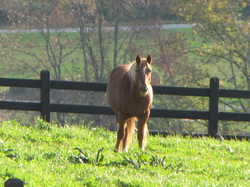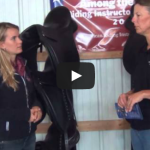I just arrived home today after a beautiful 10 days in Italy.
It was one of those trips that I could say, when asked the reason for my visit at the customs booth, was “for work,” although I feel lucky to be able to call what I do work.
The 14th Annual Conference for the International Society of Equitation Science was held this year in Rome, at a facility of the Italian military, rich with history as the training grounds of Officer Federico Caprilli, inventor of the “forward seat”, and our modern jump position in riding.
I was there to provide video and photo coverage of the event, and to learn all I could from the scientists presenting their research on horse health and behavior.
Over 52 speakers presented during the four days of the conference, and many other researchers had prepared posters to visually display their work. All were generous in discussing what their findings meant for us as horse owners and trainers.
Over the next two weeks, I will share many of my takeaways and the short interviews I did with attendees of the conference.
In this week’s collection, learn about the connection between girthy behavior and how a horse is managed, the difference in muscle engagement for the rider working at walk, trot, or canter, and the behavioral meaning of the “lick and chew”.













57 Responses
Thank you so much for these wonderful video clips-I learned so much from them!
Things that I wondered about like types of housing affecting riders for one.
Keep the videos coming-I am eager to learn more-Thanks again for all you do!
Glad you enjoyed the video Sandi! 🙂
-Julia Burdy, CRK Training Community Manager
Top job Callie and film crew as I’m really interested in learning more about the licking and chewing and their findings. I look forward to seeing the upcoming videos of this event and what you learnt from the science’s perspective on horses
Great interviews Callie!
Such interesting information coming out of the scientific community to support the welfare of horses.
I love that!
Watched a couple of you videos & looking forward to watching more- so pleased I found you.
Cheers Sarah
Glad to have you here on our blog Sarah!
-Julia Burdy, CRK Training Community Manager
WowCallie! This is great stuff! Thanks so much for sharing your trip with us! Keep it coming!
Fantastic, great topics and amazing oppurtunity. We all gain so much from your
Constant curiosity , exploration and education that you share!!!
Very interesting interviews Callie. Looking forward to more of these.
Thank you for sharing. It is SO interesting. We really need more scientific approaches in the field.
I am really impressed you spent the time and money to attend this conference.
Very interesting Callie, thank you for sharing, as it all helps awareness on our part to help our equine friends. Look forward to further videos.
Wonderful, so exciting to hear all this news, and so glad you are a part of this international Community. I was very interested in the noseband issue, I didn’t quite understand the liking and chewing topic so will be looking out for more, I found it fascinating re horses being kept in herds or boxes and their potential behaviour in being saddled up (ours our loose, in a herd all year round and I’ve never heard of anyone having problems while handling or saddling them). Well done team CRK training and all these scientists and researchers. Loved hearing the Irish accent too!!!
Callie,
Thanks for sharing!! How interesting about the left side of the horse being different where the saddle goes and one of the possible reasons being the mounting from the left consistently. I had an equine chiropractor tell me many years ago that if mounting from the ground to alternate between mounting on the left and right sides, but not necessarily needed when using a mounting block. But, I think I’m going to start alternating even when using the mounting block and having my students do so as well.
I would love to see saddle makers change the shape of the trees so that they distribute the weight evenly over the back but not restrict shoulder movement in any way. Basically figure out a way to get rid of the front part of the tree, as I have found on some horses that it’s almost impossible to find a saddle that does not restrict one shoulder or the other.
Kathy, myself and the other riders here at Callie’s barn find ourself in constant search of the perfect saddle – which we are convinced is that is at the bottom of the rainbow instead of a pot of gold! There are some saddle makers who have panels that allow for more freedom of the shoulder!
-Julia Burdy, CRK Training Community Manager
love it….can’t wait for more
Thank you for sharing this experience with me. Your love and devotion to horses and horse behavior continually motivates me to become a better rider and horse owner. Thank you also for “freely” sharing your training videos with the horse public.
Our pleasure Katy! Glad you enjoyed them and happy to have you as a member of our community 🙂
-Julia Burdy, CRK Training Community Manager
I didn’t catch the name of the gentleman you interviewed on today’s video. Would you please post that? I’m interested in checking out his work.
Thank you so much for sharing your experiences there.
Sharon
Sharon, I think you are referring to Andrew McLean!
-Julia Burdy, CRK Training Community Manager
I really appreciate you sharing these findings with us, I am fascinated by animal behavior and can’t learn enough fast enough. As others have said, I didn’t quite understand the takeaway from the licking/chewing segment, would love to hear more about that. Great presentation! Ciao.
Linda, licking and chewing is a result from relaxation after tension! Did you have a specific question?
-Julia Burdy, CRK Training Community Manager
I didn’t understand the licking and chewing part either as the woman mentioned that horses did it when they were being submissive AND when they were being aggressive.
Excellent Callie! So glad you had the opportunity to go to Italy to the International Conference along with Ken. The video clips you shared were wonderful and I can’t wait to hear more about what you learned while you were there. The licking and chewing piece was interesting and I also found the results about the housing of horses quite interesting as it related to saddling and safety.
Thank you for sharing with us what you learned and looking forward to hearing more.
Nancy B
Glad you enjoyed the video Nancy!
-Julia Burdy, CRK Training Community Manager
Your blogs are so informative and helpful to those of us who struggle sometimes. I am 7 months on from a terrible on ground horse related injury to my arm, wrist and hand resulting in plates, screws, pins, wires and lots of physio which is ongoing. I am 54 and have been back lucky enough to own my horses for the last 9 years after a good 20 year break. I find as an older rider, I am a little more cautious than when I was a mere 20 something. Your blogs are invaluable as they are easy to understand and i’m having a few “lightbulb” moments which is a wonderful feeling and certainly helps put some scary moments into perspective. I can certainly identify with you interview with Tina O’Connor concerning life anxieties and life experiences, which is why, I think I need the connection so much with my horses. I always feel happy and content with life after being with them and am gradually conquering my demons. Thank you for sharing all the wonderful knowledge gleaned from Italy…looking forward to the next blog!
Tracey (UK)
Tracey, have you watched our free training from our Calm and Confident Rider program? I think you would find it immensely helpful 🙂
-Julia Burdy, CRK Training Community Manager
Fantastico! I hate tight nose bands. When I first started my lessons and was told to use 2 fingers, but one had me put the fingers on the underside of the chin. I started using the topside and kept questioning the need for any nose band at all. As time passed, I keep securing the band one space looser than one more space looser. I can’t judge a significant difference in the horse, but the stables stopped trying to get me to do it tighter and I feel better and I think Hank drops his head more during lessons. P.S. I saw that rascally terrier wandering the grounds in one of the interviews. He looks like he owns the joint!!!
Wasn’t he cute?! Agreed on the tight nosebands – not only are they more comfortable but it helps the horse properly use their jaw when riding!
-Julia Burdy, CRK Training Community Manager
It always amazes me how much human horse guardians do not learn about or utilize the known “natural” behaviors of equines before they take on the responsibility of having one. But it does take scientific research to adequately convince and inform people that behaviorally, physically, psychologically it is better for these wonderful beings to live in a herd situation as they were intended and evolved. I know many horse people who consider their horses “pampered and lucky” to live in a box stall and not have to fend off the weather or other horses for food. Wonder how those people would like to live in their bathroom all the time and only be let out when convenient for their caretakers.
Great work Callie! Keep spreading the information!
Love the points your brought up here! We need science I suppose to show the proof that horses prefer to live in certain ways, I think most people think they are doing favors for their horses by keeping them stalled – great analogy of us living in just our bathrooms!
-Julia Burdy, CRK Training Community Manager
Thanks Callie, that was so interesting. Really looking forward to seeing more.
These were really interesting interviews Callie! I look forward to hearing lots more about what you learned! I would so love to attend one of these conferences! Thats’s probably too many exclamation points for one post but oh well….
I can understand and feel your excitement 🙂
-Julia Burdy, CRK Training Community Manager
Hi Callie. Very interesting thank you for sharing with us. I’m really looking forward to your opinions on these topics, and what did you hear that was totally new & surprising, if any.
What a wonderful opportunity for you to attend this conference in Rome! Sounds like you had a great trip and learned a lot! What a beautiful place to have the conference! I truly appreciate you sharing with us what you learn, and I look forward to seeing more from your trip. (and I love hearing all the accents in the interviews!) Excellent job, Callie!
Teri, glad you enjoyed the video! Can’t wait to share more!
-Julia Burdy, CRK Training Community Manager
Thank you, Callie, for sharing this valuable information with us. I am looking forward to watching the upcoming videos and hearing about new insight and research that will help my horse feel more comfortable and make our time together even more enjoyable than it already is.
Wow, very exciting! Thanks Callie for all u do! This is a great time for horses and I’m so glad to be in it right now.
Donna, glad to have you as a part of our community!
-Julia Burdy, CRK Training Community Manager
How do I get to the “girthy horse” video?
Bambi, that was the part about how much turnout horses are getting correlating to being ‘girthy’!
-Julia Burdy, CRK Training Community Manager
FANTASTIC!! It is so great that you were able to attend this conference! Thank you so much for sharing the interviews/information with us!! I feel so lucky to have found you online…Are you sure you do not want to move to Northern California? LOL
Haha! We have many fun events here at the farm you are welcome to travel in for – the scenery here is beautiful! 🙂
-Julia Burdy, CRK Training Community Manager
Very interesting comments and findings. Thanks for sharing Callie
Glad you enjoyed Sue!
-Julia Burdy, CRK Training Community Manager
I’m happy to know there are so many people working to improve the lives of horses and their humans. Is there research like this going on here in the US? How do I find out more? Thanks!
Yes! I would check with their site, you can click here to access it!
-Julia Burdy, CRK Training Community Manager
I have enjoyed the videos, but my comment is about the website and how to find things. I ride a friend’s horse once or twice a month. My friend is also a trainer, and uses many of the techniques you present. The horse is calm and well behaved, and the three of us seem to be a good combination. I’m eager to get into the paid training videos, but with the infrequent riding, it will take me several months to even try all the basic stuff! Can I stay on the list for the paid programs until I have more time in the saddle? Or, do the paid programs include things that could help me at my current stage?
Back to the website and how to find things, particularly specific vids that I’ve seen but not viewed at that visit?
Thanks!
Delvan
Hi Delvan! I would say that the paid programs would be a great fit for you, even if you aren’t riding all the time. Many of the members of our paid programs are actually taking lessons about once a week! There is a a search feature on the top of the right column on the home page and at the bottom of the webpage as well! If you are interested in taking a course but you aren’t sure which one is for you, click here to fill out our quiz and find the resources best suited for you.
-Julia Burdy, CRK Training Community Manager
I’m not clear on her findings about licking and chewing. To me it sounded as if horses do it when they are and are not relaxed. Can you please explain this to me. Thank you!
Sandra, it is caused by the horse coming down after a period of stress!
-Julia Burdy, CRK Training Community Manager
In my lesson last night and my horse didn’t quite do what I asked, my instructor Nicki reassured me saying “it’s good, Hank didn’t blow up or toss his head, instead he is licking and chewing in a relaxed way and it shows he is thinking about it and may get the cue later.” I know she didn’t mean he was intellectualizing but I like to think of it as a time for absorbing what just happened.
I loved this video! Very good information. Thank you so much for sharing!
Thank you Carolyn, glad you enjoyed it!
-Julia Burdy, CRK Training Community Manager
Dear Callie, when I retire from my current job, can I please just be your barn slave? That really sounds like my dream job, LOL. In the dog show world, we call that the bucket b*tch (not obscene since that is the correct term for a female dog, this person is just the helper for the handler in the show ring). You do the most interesting things and we learn so much through it! Thanks for sharing all of this!
Haha! We’d love that Katrina 🙂 Glad to have you as a part of our community!
-Julia Burdy, CRK Training Community Manager
Thank you for sharing some of what you learned at the conference. It’s esp[ecially impressive that the researchers seem to have the well being of the horse in mind, and it’s good to know there is new information available that can help us to take care of ours better.